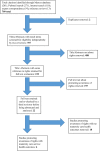Do Interventions that Promote Awareness of Rights Increase Use of Maternity Care Services? A Systematic Review
- PMID: 26444291
- PMCID: PMC4596618
- DOI: 10.1371/journal.pone.0138116
Do Interventions that Promote Awareness of Rights Increase Use of Maternity Care Services? A Systematic Review
Abstract
Twenty years after the rights of women to go through pregnancy and childbirth safely were recognized by governments, we assessed the effects of interventions that promote awareness of these rights to increase use of maternity care services. Using inclusion and exclusion criteria defined in a peer-reviewed protocol, we searched published and grey literature from one database of studies on maternal health, two search engines, an internet search and contact with experts. From the 707 unique documents found, 219 made reference to rights, with 22 detailing interventions promoting awareness of rights for maternal and newborn health. Only four of these evaluated effects on health outcomes. While all four interventions promoted awareness of rights, they did so in different ways. Interventions included highly-scripted dissemination meetings with educational materials and other visual aids, participatory approaches that combined raising awareness of rights with improving accountability of services, and broader multi-stakeholder efforts to improve maternal health. Study quality ranged from weak to strong. Measured health outcomes included increased antenatal care and facility birth. Improvements in human rights outcomes such as availability, acceptability, accessibility, quality of care, as well as the capacity of rights holders and duty bearers were also reported to varying extents. Very little information on costs and almost no information on harms or risks were described. Despite searching multiple sources of information, while some studies did report on activities to raise awareness of rights, few detailed how they did so and very few measured effects on health outcomes. Promoting awareness of rights is one element of increasing demand for and use of quality maternity care services for women during pregnancy, birth and after birth. To date efforts have not been well documented in the literature and the program theories, processes and costs, let alone health effects have not been well evaluated.
Conflict of interest statement
Figures
References
-
- United Nations. International Conference on Population and Development Program of Action. New York: United Nations Population Fund; 1994. p. 296.
-
- Starrs A. The Safe Motherhood action agenda: priorities for the next decade. Report on the Safe Motherhood Technical Consultation, 18–23 October 1997, Colombo, Sri Lanka New York: Inter-Agency Group for Safe Motherhood, 1997.
-
- United Nations Economic and Social Council. General Comment No. 14: The Right to the Highest Attainable Standard of Health (Art. 12 of the Covenant). Geneva: UN Committee on Economic, Social and Cultural Rights (CESCR); 2000.
-
- United Nations Office of the High Commissioner for Human Rights. Fact Sheet No. 31, The Right to Health. Geneva: OHCHR; 2008.
-
- United Nations Secretary General. Global Strategy for Women's and Children's Health. New York: Partnership for Maternal, Newborn and Child Health; 2010. p. 20.
Publication types
MeSH terms
Grants and funding
LinkOut - more resources
Full Text Sources
Other Literature Sources
Medical



